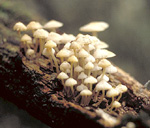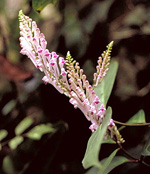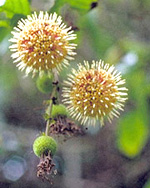CAO BANG
All images on this site: Dan Harder
 Mushrooms, Thang Hen District |
 Thang Hen District |
 Labiatae, Thang Hen District |
 Uncaria sp. (DKH 4248), Thang Hen |
Total Area: 663,798 ha.
Population: 611,000
Provincial town: Cao Bang (at the confluence of the Mang Hieu and Tra Vinh rivers)
Districts: Bao Lac, Thong Nong, Ha Quang, Tra Linh, Trung Khanh, Nguyen Binh, Hoa An,
Quang Hoa, Thach An, Ha Lang.
ETHINIC DIVERSITY Nine major ethnic groups are located here including the Tay, Nung, Dao, and H'mong.
PHYSICAL The landscape of Cao Bang is unique. Massive limestone deposits, dating from the Paleozoic age and reaching a depth of over 1000m, occupy a large portion of the province. Powerful geological uplifts during the Mezozoic raised these limestone ridges to considerable heights, where erosion produced dramatic massif and rocky outcrops, particularly along the southern margin. Further erosion produced highly dissected and isolated mountain ridges and column-like mesae. Average elevation is 600-1000m, but reach nearly 1400-1500m in the extreme northwest portion of the province. Lower valley areas are found between 300 to 1000m. The largest mountain areas in Cao Bang are of granitic and related substrates and occur mainly in the western part of the province. These rise to elevations of 1978 m.
SEASONS Cao Bang experiences four distinct seasons. Summers are hot (25°-30° C) with abundant rainfall (150-300 mm). Winters are dry and rather cool (near 15° C at 200-300m).
BIOLOGICAL Plant and animal diversity is extraordinarily high for two reasons: Cao Bang's position between two floristic kingdoms, the Holartic and Palaeotropic, and diverse natural conditions. The biological richness of the province has scarcely been recognized since few botanical expeditions have focused on this region. Recent investigations have resulted in new species discoveries and descriptions of its rich forest communities which are unique to Viet Nam. Cao Bang and other northern provincial locations may harbor the highest botanical diversity in all of Viet Nam and possibly Indochina.
Within the Northern Indochina Subtropical Forests of Cao Bang, mixed forests of evergreen and coniferous tree species occur. Three protected areas are designated in this province, Trung Khanh, Nature Reserve, Nui Pia Oac Nature Reserve and one cultural and historic site, Pac Bo, covering a total of only 21,908 ha, (less than 18%) of the total natural forest area of 122,486 ha. Due to extensive logging and land conversion, only 18% of the total land area is covered in natural forest. The Black Gibbon (Hylobates concolor) has been recorded from within Cao Bang but the status and distribution of this species is poorly known.
THREATS: The potential for hydroelectric development within Cao Bang could have severe effects on the biodiversity of this rich region.

